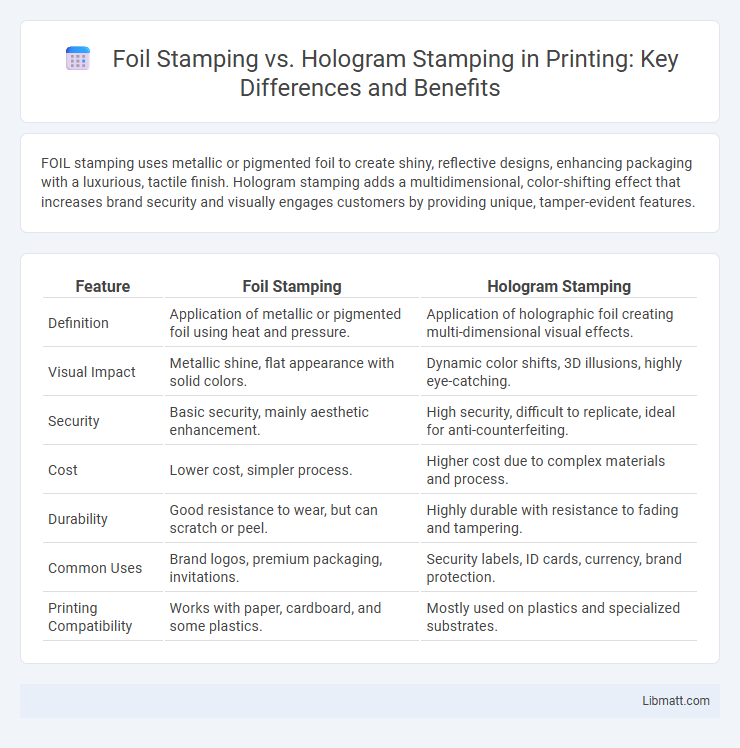FOIL stamping uses metallic or pigmented foil to create shiny, reflective designs, enhancing packaging with a luxurious, tactile finish. Hologram stamping adds a multidimensional, color-shifting effect that increases brand security and visually engages customers by providing unique, tamper-evident features.
Table of Comparison
| Feature | Foil Stamping | Hologram Stamping |
|---|---|---|
| Definition | Application of metallic or pigmented foil using heat and pressure. | Application of holographic foil creating multi-dimensional visual effects. |
| Visual Impact | Metallic shine, flat appearance with solid colors. | Dynamic color shifts, 3D illusions, highly eye-catching. |
| Security | Basic security, mainly aesthetic enhancement. | High security, difficult to replicate, ideal for anti-counterfeiting. |
| Cost | Lower cost, simpler process. | Higher cost due to complex materials and process. |
| Durability | Good resistance to wear, but can scratch or peel. | Highly durable with resistance to fading and tampering. |
| Common Uses | Brand logos, premium packaging, invitations. | Security labels, ID cards, currency, brand protection. |
| Printing Compatibility | Works with paper, cardboard, and some plastics. | Mostly used on plastics and specialized substrates. |
Introduction to FOIL Stamping and Hologram Stamping
FOIL stamping utilizes heat, pressure, and metallic or pigmented foils to create a shiny or matte decorative design on various surfaces, enhancing product packaging and print materials with a luxurious metallic finish. Hologram stamping employs laser-etched images on a reflective surface, producing multi-dimensional, color-shifting effects that provide both security features and eye-catching visual appeal. Both techniques are widely used in branding, authentication, and high-end product decoration across industries like cosmetics, finance, and luxury goods.
Understanding the FOIL Stamping Process
FOIL stamping involves applying a metallic or pigmented foil onto a surface through heat and pressure, creating a vibrant and durable finish that enhances the visual appeal of printed materials. This process uses a metal die to transfer foil, allowing precise designs and sharp details, which is ideal for adding luxurious effects to packaging, business cards, or invitations. Understanding your project's requirements helps determine whether foil stamping's tactile shine or hologram stamping's unique light-diffracting patterns best suit your branding needs.
How Hologram Stamping Works
Hologram stamping involves embedding three-dimensional images using laser-etched microstructures that reflect light to produce dynamic, multi-colored visual effects, ensuring high security and counterfeit resistance. This process utilizes a combination of diffraction gratings and embossing techniques on thin metallic foils to create distinct holographic patterns transferred onto products during stamping. Compared to traditional foil stamping, hologram stamping provides enhanced brand protection through complex visual elements that are difficult to replicate or alter.
Key Differences Between FOIL and Hologram Stamping
FOIL stamping uses metallic or pigmented foil pressed onto surfaces with heat and pressure, creating a shiny, reflective finish primarily for decorative text or logos. Hologram stamping incorporates a three-dimensional image embedded into the foil, offering enhanced security features such as anti-counterfeiting measures and visual depth. The main differences lie in the visual complexity and security level, with hologram stamping providing advanced protection compared to the simpler aesthetic effect of foil stamping.
Visual Effects and Aesthetic Appeal
Foil stamping produces a shiny, metallic finish that enhances packaging and printed materials with a reflective, premium look, often used in luxury branding. Hologram stamping offers dynamic, multi-dimensional visual effects with rainbow-like color shifts and movement, creating an eye-catching and futuristic appeal. Both techniques elevate aesthetic appeal, but holograms provide a more complex and high-tech visual experience compared to the flat metallic sheen of foil stamping.
Security Features: FOIL vs Hologram Stamping
FOIL stamping provides basic security by using metallic or pigment-based foils that offer tamper-evident qualities and visual appeal, though it can be replicated more easily. Hologram stamping incorporates complex, multi-dimensional imaging with microtext, diffraction patterns, and unique identifiers, making it significantly harder to counterfeit and enhancing product authentication. You can choose hologram stamping for superior protection against fraud or foil stamping for cost-effective decorative security.
Durability and Longevity Comparison
FOIL stamping offers high durability with resistance to fading and abrasion, making it ideal for long-lasting designs on packaging and printed materials. Hologram stamping provides enhanced security features with its multi-dimensional visual effects but may be more susceptible to wear over time due to its delicate surface structure. Choosing between foil and hologram stamping depends on the balance between aesthetic longevity and anti-counterfeiting needs.
Application Areas for Each Stamping Method
FOIL stamping is widely used in packaging, book covers, and cosmetic labels due to its vibrant metallic finishes and cost-effectiveness for large runs. Hologram stamping excels in security-sensitive applications such as credit cards, ID badges, and product authentication to prevent counterfeiting. Your choice depends on whether decorative appeal or anti-counterfeit features are the primary requirement.
Cost Considerations and Production Efficiency
FOIL stamping generally incurs lower material costs compared to hologram stamping, making it a cost-effective choice for budget-sensitive projects. Hologram stamping involves more complex production processes and specialized equipment, which can increase both setup time and manufacturing expenses. Production efficiency is higher with foil stamping due to its faster processing speed and simpler application methods relative to the intricate and precise alignment required for hologram stamping.
Choosing the Right Stamping Technique for Your Project
FOIL stamping offers a cost-effective, vibrant metallic finish ideal for luxury branding and simple designs, while hologram stamping provides advanced security features with dynamic, multi-dimensional effects perfect for anti-counterfeiting and premium packaging. Selecting the right technique depends on your project's goals: prioritize foil stamping for elegance and high visual impact or hologram stamping for enhanced authenticity and protection. Consider factors like budget, design complexity, and desired visual or security outcome to ensure optimal results.
FOIL stamping vs hologram stamping Infographic

 libmatt.com
libmatt.com